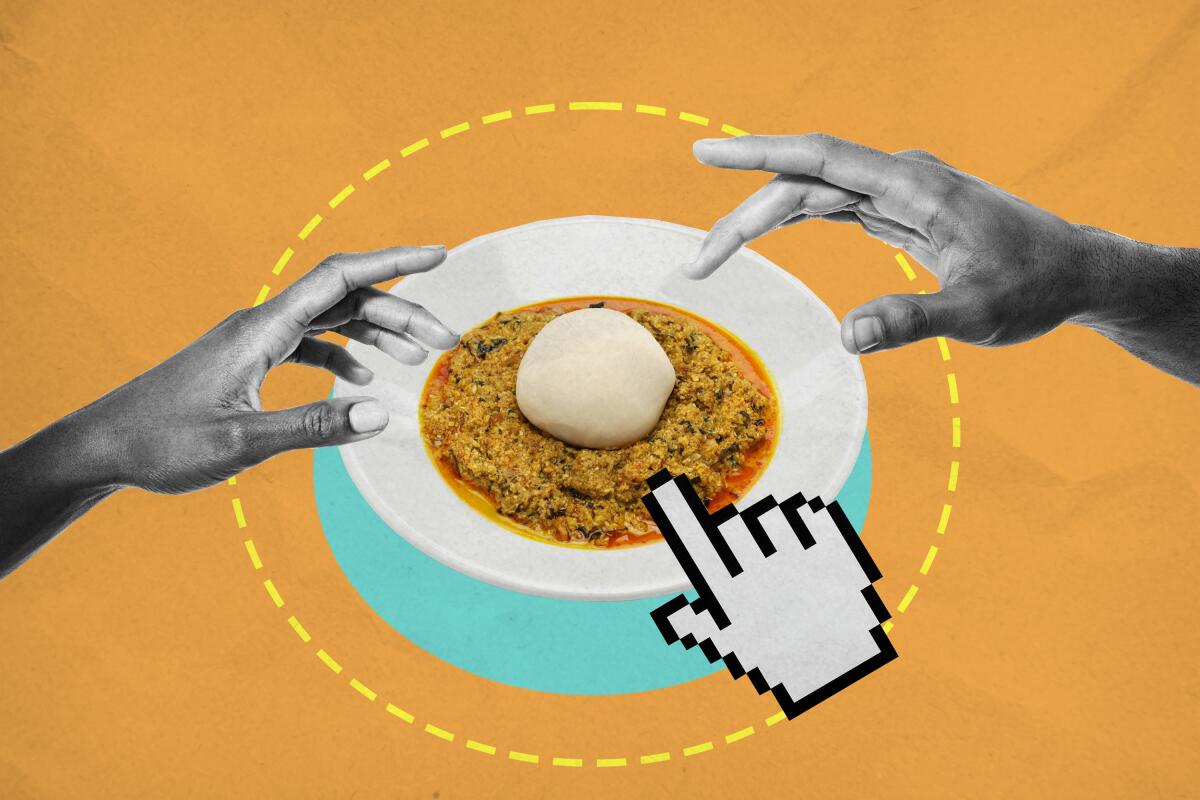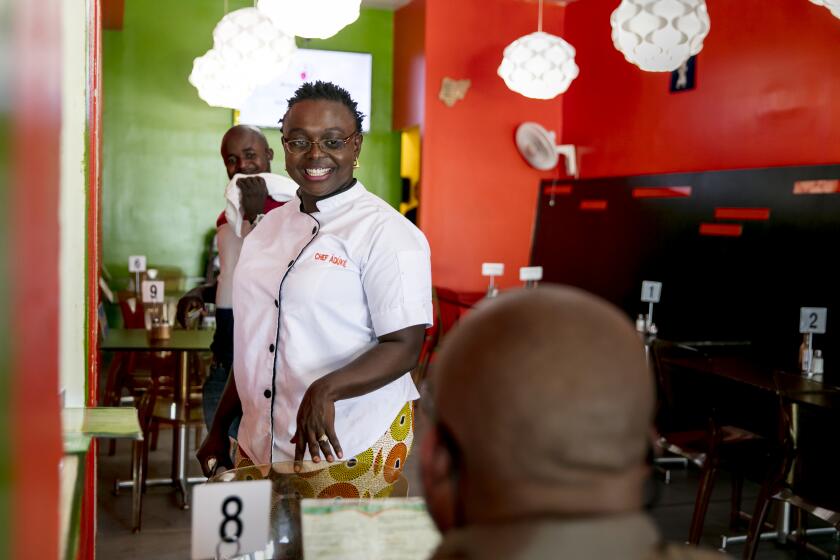TikTok is flipping out for Fufu. How a West African staple went viral

Joeneen Hull had never tried fufu, but for weeks the 31-year-old nail artist watched mukbangs of people dipping warm chunks of starchy dough into rich, spicy soups.
âOne day, I was just like, âYou know what? Todayâs gonna be the day,ââ she said. âIâm craving it so bad. I donât even know what this food tastes like and Iâm craving it.â
On Jan. 4, she drove nearly 80 miles from Moreno Valley to Veronicaâs Kitchen, a Nigerian restaurant in Inglewood. At first, she was determined to order multiple soups and showed an employee several pictures from the restaurantâs Yelp page. He suggested one would be more than enough. She settled on two: egusi and okro (okra) soup.
From her car, still parked outside the restaurant, she filmed herself as she dipped a mouthful of dough into the okro soup. âBomb â it is so worth it,â she said to her phone camera.
Next, the egusi. âI donât know what they put it in, I couldnât even start to guess,â Hull said. âOh my goodness, itâs hitting.â
Hullâs fufu videos quickly spread on TikTok, amassing more than 6 million views, but her intention was never to go viral. âI just wanted to get some good food and record it, so that other people could see that itâs good food,â she said.
To the surprise and amusement of the African diaspora, fufu is having a moment. Across the app, #fufu videos have been watched more than 250 million times. The videos have been shared and debated publicly on Facebook, Instagram and Twitter and privately on WhatsApp and in group chats.
The #fufu or #fufuchallenge tags are a mixed bag of new fufu lovers like Hull; people who, respectfully, said it wasnât for them; people who, disrespectfully, spit it out; and members of the African diaspora gently mocking or scolding those who tried it.
One of the most prominent fufu advocates on TikTok is Keith Atowo, a 24-year-old pharmacy student from Ypsilanti, Mich. who goes by @keitheats_. He is best known for sharing videos of himself eating â and sometimes cooking â traditional West African dishes and has helped introduce fufu to scores of people, including Hull. He has more than 260,000 followers and a no-frills approach to content creation â no soundtracks or special effects. When heâs hungry, he sits in front of his camera with dishes from Cameroon â he moved to the U.S. when he was 12 â and starts each video by describing whatâs on his plate in his soothing voice. The rest of the clip consists of the sound of him tearing through his food and enjoying the dish.
Atowo said some West Africans â upset by videos of people spitting out fufu â have criticized videos like his online for turning the meal into a viral challenge. He said his goal wasnât to start a trend, but he sees the popularity of fufu as a chance to direct money to businesses in the U.S. and perhaps boost interest in travel to African countries.
âItâs a good thing that people are learning about our cultural food. Itâs a good thing that people are wanting to try,â Atowo said. âItâs not only going to create a business outlet for many African restaurants we have ... but people are going to be more intrigued to travel to Africa.â
At a minimum, it generates business locally. TikTok users like Hull generally mention where they ordered from, which has led to free publicity for small, minority-owned businesses across the country. At Veronicaâs Kitchen, business quadrupled the week after Hull highlighted the restaurant, said owner Veronica Shoyinka, who has been selling Nigerian food in Los Angeles since the â90s. A regular who visited Wednesday afternoon warmly called her âMadame TikTokâ by way of greeting.
A listing for a fiddle-leaf fig on Instagram causes houseplant fans to wonder, âWhatâs your secret?â
Many new customers had never tried Nigerian food before. Hanna Kim, a 23-year-old community health worker from Los Angeles, made the trip after thumbing through TikTok videos. She said the fufu challenge reminded her of the birria taco trend that swept the app over the summer. âI think itâs so cool how we are sharing each otherâs cultural foods and weâre able to experience that and see actual reviews of people eating it and sharing their opinions,â Kim said. (She ordered fufu and egusi soup with chicken.)
Itâs not clear how long the trend will last, but so far it has created at least one repeat customer. Two weeks after her trip to Veronicaâs Kitchen, Hull tried a second Nigerian restaurant in Inglewood, Aduke Nigerian Cuisine.
âI think like most people, by looking at it, you come up with your own idea of what it will taste like,â Hull said of fufu. âAnd then once you taste it, it tastes absolutely nothing like that.â
Hereâs a guide to trying fufu and other West African dishes:
What is fufu?
Broadly speaking, fufu is a spongy dough thatâs made by mixing yam, cassava or other flours in hot water. Itâs popular across West Africa, though various regions have different names for it depending on how itâs made. (In Nigeria, for example, âfufuâ refers specifically to the dough made from fermented cassava, while dough made from yams is called pounded yam.)
OkayAfrica has an in-depth look at the different types of fufu, but beginners should stick to yam fufu.
One mistake people sometimes make is not getting enough soup in each bite. Fufu is literally unseasoned dough that has no taste of its own. Think of it as a tool â donât dip, scoop.
Fufu is typically covered in plastic wrap. Some TikTok users believe itâs necessary to slap it. Itâs not.
There is also a debate over whether one needs to chew fufu. Traditionally itâs swallowed whole, but choking for clout isnât recommended. âChew it,â Atowo said. âIâm not going to tell someone to do something they cannot do.â
What is egusi soup?
âItâs just savory,â Hull said. âIt has a little bit of spice to it, which I love. Itâs hearty. I canât compare it to any other food.â
Egusi soup is made of dried, ground pumpkin seeds, spinach, habanero chili, tomatoes, onions, ground crayfish, palm oil and meat, such as chicken or beef.
âItâs unique,â Shoyinka said of the flavor. âA lot of people that have tried it, especially the Americans, love it because itâs pumpkin seeds, itâs what they know. They make pumpkin pie. We use it to make soup.â
Do I have to get egusi?
Egusi soup can be an acquired taste. âIf youâre just starting off, you should try jollof rice,â Atowo said. âJollof rice is just rice with seasoning, with flavor. Itâs like amplified rice.â Get the rice with a side of fried chicken or plantains.
As far as egusi alternatives go, okro soup, made with okra, is another great choice. Efo riro soup is a spinach dish and red stew, made from tomato, is simple but flavorful.
Beyond fufu, there is moi moi, which is made from black-eyed peas that have been soaked, blended, seasoned and steamed with bits of hard-boiled eggs.
Goat meat pepper soup â made by boiling seasoned meat and often served with rice â is another option, especially for people who enjoy the taste of liver and other bits of offal.
Where can I get West African food in Los Angeles?
In Inglewood, Veronicaâs Kitchen and Aduke Nigerian Cuisine (previously located in Mid-City) both serve traditional Nigerian meals.
Bill Addison reviews Mid-Cityâs Aduke African Cuisine, a welcoming restaurant that specializes in Nigerian stews and rice dishes.
Mama Dâs African Cuisine, a new African restaurant in Boyle Heights, offers a Cameroonian spin on West African food, as does the African Chop food truck.
More to Read
Sign up for The Wild
Weâll help you find the best places to hike, bike and run, as well as the perfect silent spots for meditation and yoga.
You may occasionally receive promotional content from the Los Angeles Times.













